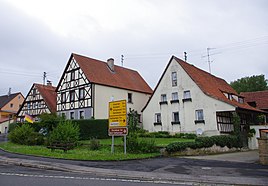Reichmannshausen
|
Reichmannshausen
Community Schonungen
Coordinates: 50 ° 7 ′ 22 ″ N , 10 ° 23 ′ 13 ″ E
|
|
|---|---|
| Height : | 341 m |
| Area : | 16.62 km² |
| Incorporation : | May 1, 1978 |
| Incorporated into: | Sparing |
| Postal code : | 97453 |
| Area code : | 09721, 09727, 09526 |
|
The Herrenseestrasse in town
|
|
Reichmannshausen is a district of the community Schonungen in the Lower Franconian district of Schweinfurt .
Geographical location
Reichmannshausen is located in the extreme north of the Schonungen municipality on the Nassach tributary Riedbach . To the north is the Ellertshauser lake with the Ellertshausen settlement , a district of Stadtlauringen . The north-east is taken by Aidhausen in the Haßberge district . The Haßberge district begins to the east with Riedbach - Humprechtshausen . In the south, connected by the district road SW 4, isakenöffelsterz . The community of Üchtelhausen begins with Ottenhausen and Hesselbach west of Reichmannshausen .
Reichmannshausen is a clearing island in the so-called Hesselbacher Waldland in the Schweinfurt Rhön. With 1662 hectares, the village now has the largest area of all places in the Schweinfurt district. There were several villages around Reichmannshausen that are now desolate and are incorporated into the district. The Franconian Marienweg runs through Reichmannshausen .
history
Reichmannshausen was probably built during the Franconian expansion phase in the 8th and 9th centuries. At that time, the colonizers from the west drove the clearing of the large forest areas. In the area of the Hesselbacher Waldland, many places with the ending -hausen emerged from the base in Wettringen . The prefix Reichmanns- probably refers to the personal name Richalm. This Frankish nobleman could have been the first owner of the village.
"Richalmeshusen" was first mentioned in a document on May 1, 1293. The Würzburg Bishop Manegold of Neuchâtel gave the abbess of the Cistercian convent Mariaburghausen a manse with land. The place name was subject to some changes in the period that followed. In 1402 they spoke of "Richmarshewsen", while in 1489 "Reichmetshausen" was called. In the Middle Ages, the place had its own village nobility who sat in a fortified manor house.
The Lords of Henneberg acquired the Mainberg castle and office in 1305 and at the same time received the rule of the village over Reichmannshausen. They then handed the village over to various fiefdoms, such as the Lords of Wenkheim , Heinrich von Troschendorf and the German lords of Münnerstadt . It was not until 1542 that the Hennebergers sold Mainberg and Reichmannshausen to the Würzburg prince-bishop. The Würzburg bishopric remained ruler of the village until secularization .
For a long time, the church belonged to the original parish of Wettringen. Probably also in Reichmannshausen some residents adhered to the Lutheranism in the 16th century, the Counter-Reformation was carried out by the Würzburg bishops. It was not until the Thirty Years' War in 1631 that the people of Reichmannshausen came to the parish of Aidhausen, and then to Ebertshausen in 1723. The village came to Bavaria in 1803 after the Würzburg monastery was dissolved . On May 1, 1978, the community was incorporated into Schonungen.
Attractions
The center of the place is still today the Catholic parish church St. Georg. It originated in the middle ages. Between 1612 and 1614, Bishop Julius Echter von Mespelbrunn raised the church tower and attached the pointed helmet that is still preserved today. The present nave was built in the 17th century . Inside, the two large side altars characterize the nave. They come from the Theres monastery church and were created by Balthasar Esterbauer from Würzburg . The altar leaves, however, are by Conrad Geiger from Schweinfurt.
In addition, many single-storey farmhouses from the 19th century have been preserved in the village. They are mostly built with a gable roof . Today the originally plastered half-timbering is mostly exposed and characterizes the townscape. The many wayside shrines in the village and in its corridors are also typical of a Catholic village in Franconia . Most of them come from private foundations. Several wayside shrines from the 18th century have been preserved in Reichmannshausen.
Two chapels on the outskirts are more recent and go back to the foundation of a Reichmannshausener. In 1982 the so-called Johanneskapelle was built on the road to Ebertshausen . Inside, the woodcarver Lothar Bühner created several copies of Tilman Riemenschneider's figures . The so-called forest chapel with its impressive half-hip roof also has a relief by Bühner. It was erected in 2004.
Personalities
- Liborius Wagner (1593–1631), Catholic priest and martyr , Wagner hid in the Reichmannshausen schoolhouse during the Thirty Years' War and was arrested here on December 8, 1631, in 1974 a memorial stone was created for the blessed.
literature
- Karl-Heinz Hennig: District of Schweinfurt. Northwestern part: art, culture and history. From the Haßberge to the Franconian wine country . Schweinfurt 2008.


